The Distinguished University of Lodz in Poland has organized the “8th Scientific Conference Faces of War – Tools of War” which was held on June 1-2, 2023. As stated by the European University Association on February 24, 2023:
“The conference “Faces of war” is an event that has been organised by EUA member University of Łódź, Institute of History, since 2017 and is attended by over a hundred participants every year. This year’s conference will be held on 1-2 June 2023 and the topic will be “War and Society”.

As further averred by the Compostela Group of Universities on March 21, 2023:
“The Institute of History of the University of Lodz … which has been organizing the conference since 2017, is cooperating with the Faculty of Philosophy and History, the Ministry of Education and Science, the headquarters of the State Archives and the Polish Historical Society’s branch in the city. The … topics are war damage and reconstruction, migration and demographic losses, health effects of wars, the impact of wars on culture and art, cultural and religious conflicts, changes in social structures, the impact of wars on the army and the military, archaeological study of battlefields, and burials of conflict victims.“
Kaveh Farrokh presented on the topic of: “An Examination of Sassanian Siege Warfare (3rd to 7th centuries CE)”. For more on the topic of Sassanian armies and military history kindly consult:
- Farrokh, K., Karamian, Gh. & Karamian, H. (2021). Military Architecture and the Four-Spāhbed System for Defense of the Sassanian Empire (224-651 CE). HISTORIA I ŚWIAT: ACTA MILITARIA IRANICA, 10, pp.117-151.
- Farrokh, K. (2021). La marea Sasánida [The Sassanian tide]. Desperta Ferro Antigua y Medieval, 66, pp.12-17.
- Dwyer, B., Farrokh, K., & Khorasani, M.M. (2021). Sassanid Armor: Background, Development and Technology. SHEDET [Fayoum University, Faculty of Archaeology], Issue No 7, pp.145-183.– See News release …
- Farrokh, K., & Khorasani, M.M. (2020). Die Sassanidische Infantrie [The Sassanian Infantry]. Pallasch: Zeitschrift für Militärgeschichte. Organ der Österreichischen Gesellschaft für Heerskunde, No. 71, February 2020, pp. 25-35.
- Farrokh, K., Sánchez-Gracia, J., & Maksymiuk, K. (2019). Caucasian Albanian warriors in the armies of pre-Islamic Iran. HISTORIA I ŚWIAT, 8, pp.21-46.
- Farrokh, K., Maksymiuk, K., & Sánchez-Gracia, J. (2018). The Siege of Amida (359 CE), Siedlce University: Publishing House of Siedlce University of Natural Sciences and Humanities.
- Farrokh, K., Khorasani, M. M., & Dwyer, B. (2018). Depictions of archery in Sassanian silver plates and their relationship to warfare, RAMA (Revista de Artes Marciales Asiáticas). Volumen 13 (2), Julio-Diciembre, pp. 82-113.
- Farrokh, K., Karamian, Gh., & Maksymiuk, K. (2018). A Synopsis of Sassanian Military Organization and Combat Units. Teheran Azad University & Siedlce University: Publishing House of Siedlce University of Natural Sciences and Humanities.
- Farrokh, K. (2017). Armies of Persia: the Sassanians. Barnsley, England: Pen & Sword Publishing.
- Farrokh, K., Karamian, Gh., Kubic, A., & Oshterinani, M.T. (2017). An Examination of Parthian and Sasanian Military Helmets. In “Crowns, hats, turbans and helmets: Headgear in Iranian history volume I” (K. Maksymiuk & Gh. Karamian, Eds.), Siedlce University & Tehran Azad University, pp.121-163.
- Farrokh, K., Karamian, Gh., Delfan, M., Astaraki, F. (2016). Preliminary reports of the late Parthian or early Sassanian relief at Panj-e Ali, the Parthian relief at Andika and examinations of late Parthian swords and daggers. HISTORIA I ŚWIAT, No.5, pp. 31-55.
- Farrokh, K. (2007). Shadows in the Desert: Ancient Persia at War-Персы: Армия великих царей-سایههای صحرا-. Oxford, England: Osprey Publishing.
- Farrokh, K. (2005). Elite Sassanian Cavalry: 226-651 AD-اسواران ساسانی-. England: Osprey Elite Series 110, Osprey Publishing.
- Maksymiuk, K. (2015). Geography of Roman-Iranian Wars: Military Operations of Rome and Sasanian Iran. Scientific Publishing House of Siedlce University of Natural Sciences and Humanities, Poland.
The presentation at Lodz University provided a comprehensive synopsis of Sassanian siege warfare from the 3rd to 7th centuries CE.
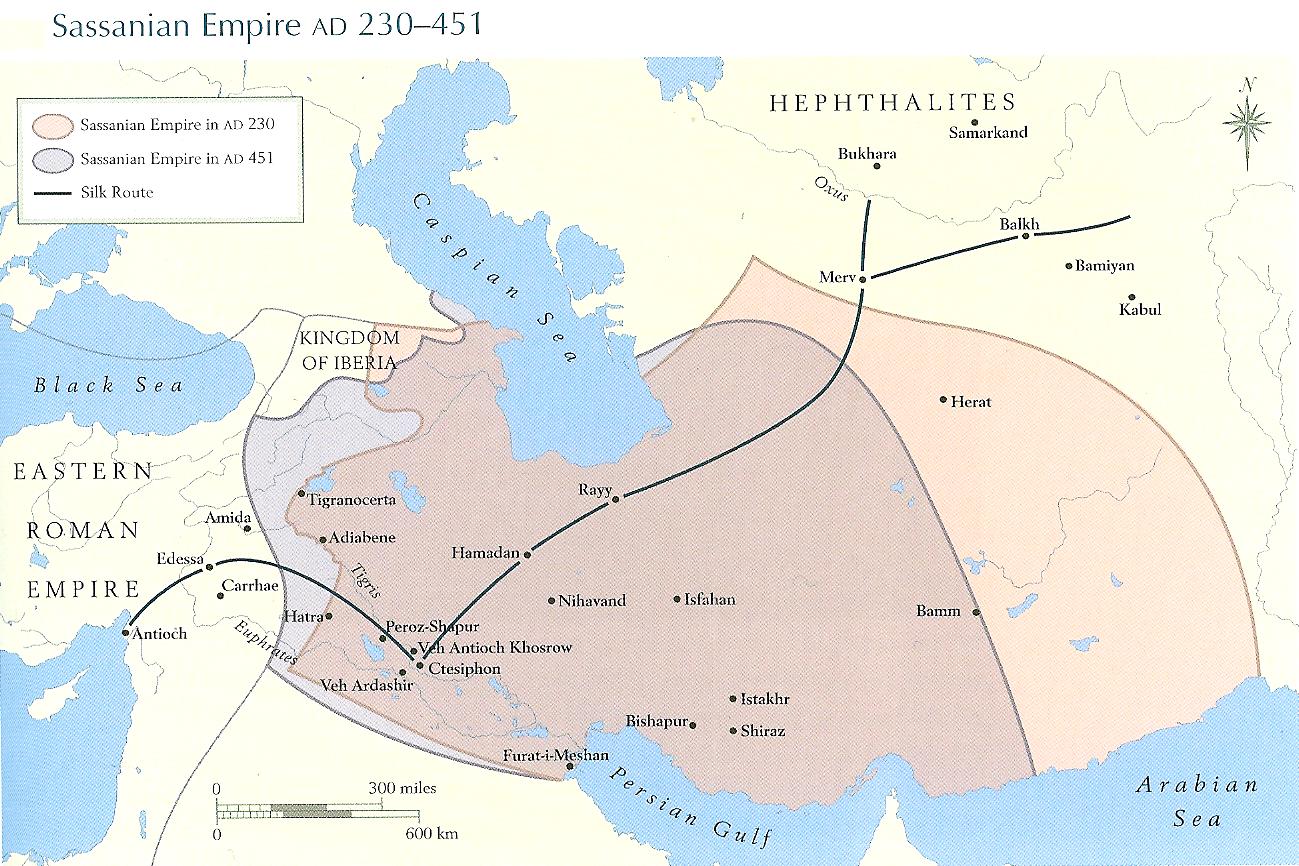
A map of the Sassanian Empire in 230-450 CE drafted by Kaveh Farrokh on page 187 (2007) for the book Shadows in the Desert: Ancient Persia at War-Персы: Армия великих царей-سایههای صحرا-:
This article examines Sassanian siege warfare and technology in the domains of ballistae, “scorpions”, catapults, and battering rams.
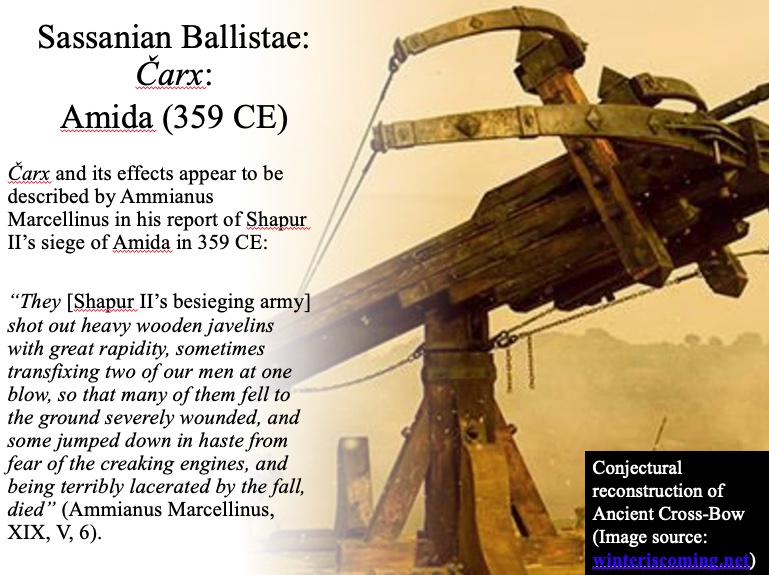
One of the lecture slides pertaining to Sassanian siege engines presented by Kaveh Farrokh during the “8th Scientific Conference Faces of War – Tools of War” held at The University of Lodz in Poland in June 1-2, 2023.
Sassanian siege warfare necessitated the use of protection-shielding for personnel (combat troops, engineers, laborers), mounds, mining, scaling of walls, as well as the digging of ditches and trenches. Archery barrages played a seminal role in support of siege operations.
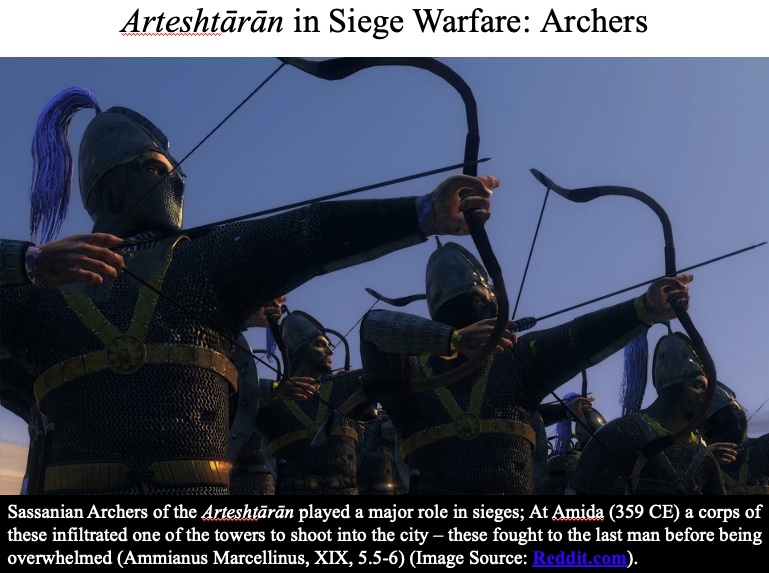
One of the lecture slides pertaining to Sassanian archers during sieges presented by Kaveh Farrokh during the “8th Scientific Conference Faces of War – Tools of War” held at The University of Lodz in Poland in June 1-2, 2023.
The Arteshtārān (lit. warriors; mainly Paighan infantry, archers and Savārān cavalry) and Pil–Savār war elephants would undertake in combat operations (for example at Nisibis 350 CE) with manual labor provided by peasant recruits.
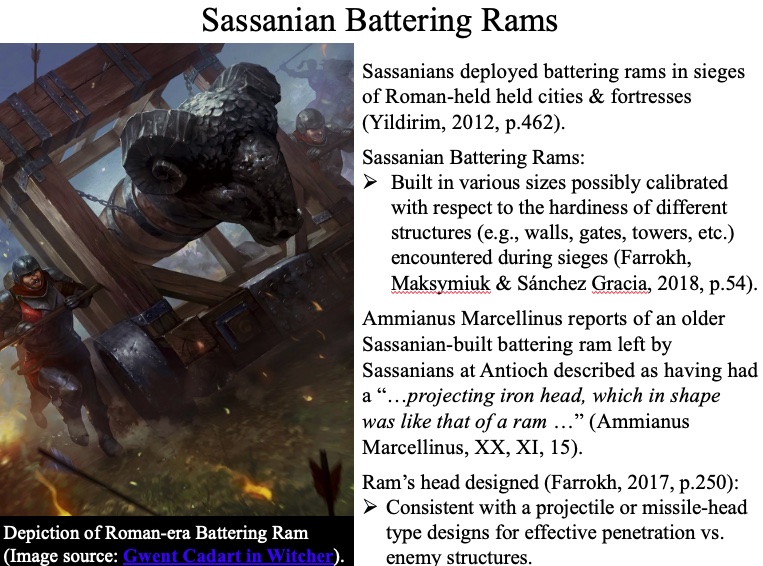
One of the lecture slides pertaining to Sassanian siege engines presented by Kaveh Farrokh during the “8th Scientific Conference Faces of War – Tools of War” held at The University of Lodz in Poland in June 1-2, 2023.
The environmental element of water was utilized (for example during the sieges of Nisibis, 337 or 338 CE and 350 CE). Incendiary factors could also be weaponized in siege operations. Non-combat strategies utilized for capturing enemy cities or fortresses typically involved espionage, recruitment of fifth-column elements among the defenders and psychological warfare.
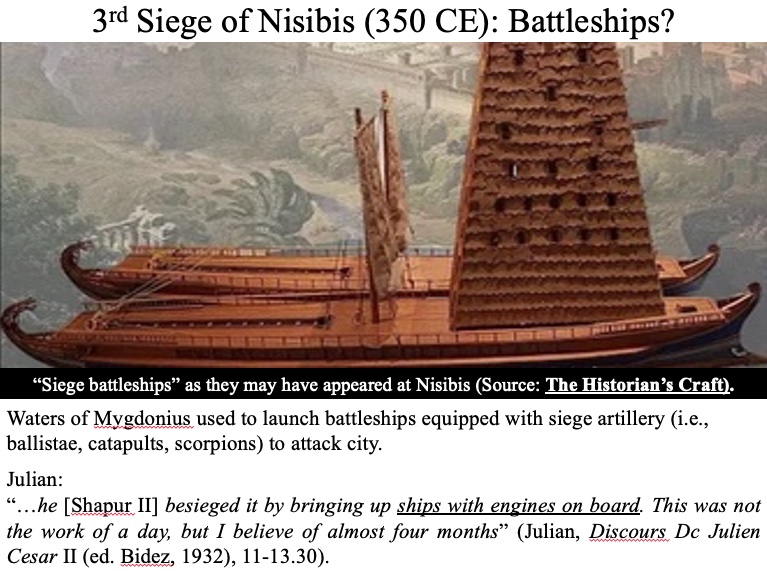
One of the lecture slides pertaining to Sassanian use of battleships in siege warfare presented by Kaveh Farrokh during the “8th Scientific Conference Faces of War – Tools of War” held at The University of Lodz in Poland in June 1-2, 2023.
In summary, Sassanian siege warfare capabilities appear to have achieved proficiency levels equivalent to contemporary Roman armies.



